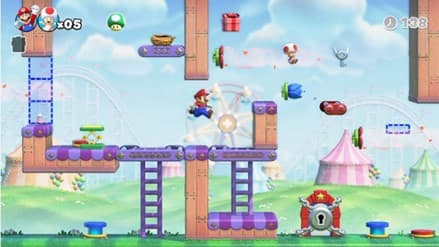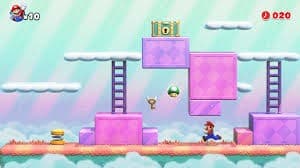Mario vs Donkey Kong for Nintendo Switch
Roles

Brief Summary
For 11 months I worked on the project Mario vs Donkey Kong for the Nintendo Switch during my contract with Nintendo Software Technology. Mario vs Donkey Kong is a remake of the original Game Boy Advance version. During this project I was tasked with the creation, internal testing, and iteration of new levels that were added to the game for the remake. I also worked on prototyping the new bonus game and time attack mode, as well as designing bonus game levels. I aided in removing softlocks from various levels and determining the time limits for the time attack game mode.
The Levels
Below are short videos of me playing through the levels I designed during the project.
I created these levels for the new worlds that were added to our remake. We had already outlined the themes for the new worlds and ideas for what enemies and obstacles might appear in them. When working on earlier levels within a world, I would start by picking out challenges, enemies, and ideas we had not yet explored in the given world. When working on a level near the end of the world, I would pick out challenges that we had the player experience in earlier levels and combine them or iterate on them in the later level for added depth and continuity of themes. A primary example of this is in World 4 where Worlds 4-6A and 4-6B incorporate a combination of warp cubes, bob-ombs, cannonballs, and fans to challenge the player with the skills they developed interacting with these obstacles in the earlier levels.
I tested the levels with various teammates and our team’s senior designer to get feedback on their experiences with the levels. Based on the feedback I received, I made several iterations to the levels, improving upon them to create what is seen in the final product.
The Bonus Stages

I also helped design the bonus games. The team wanted to replace the original bonus stages with a different kind of gameplay to make the bonus games more fun. I was tasked with creating prototypes for the bonus stages and created several demos. After I tested and iterated on these demos, we settled on a design closer to the gameplay found in the final game. Through more testing we finalized the treasure chest and key gameplay which is in the full release.
The bonus stages are based on levels that are already in the game. We did this due to time constraints since we were unsure whether we would be able to get environmental art in for brand new stage designs. Working with this constraint, I created the bonus stages for worlds 1, 4, 6, 8, 1+, 2+, 3+, 4+, 5+, 6+, and 8+.
Time Attack
I helped with prototyping the new time attack mode by doing playthroughs of all the levels in the game. I provided times for two kinds of playthroughs; one a speed run and the other a playthrough that forgoes the use of short cuts/optimized pathing. Using my times and times collected from internal and external testing, I helped implement the time limits for every stage in the game.

2 Player and Casual Mode
I played through the game’s 2 player mode and casual mode extensively to test the various new features of these modes and to seek out softlocks and bugs caused by the new mechanics. In 2 player, getting the camera to work in a manner that suited the single screen, puzzle solving gameplay was key. We tested edge cases where the camera would be zoomed far out, making it difficult to see things outside the view of the player. I gave my feedback throughout the project to help improve the camera system and proposed potential ideas for how the camera could work. I also sought out softlocks and game breaking short cuts in 2 player and casual mode. When I found these kinds of bugs, I reported them on our task managing software and if it was something I could fix myself, the senior designer would assign the task to me. Then I went and adjusted the level design accordingly to remove the softlock or game breaking short cut while trying to maintain the integrity of the original design for the level.
An example of one of the level skips I removed is from World 8-1B. In the original game, near the top of the stage just before the trapped mini, there was a wall that prevented the player from skipping the final puzzle and simply grabbing the mini. This wall did not completely cover the conveyor belt below because in the original game, Mario couldn’t get enough height to jump through the conveyor belt and skip the whole level. In 2 player, bouncing off your partner’s head to jump through this gap became a possibility. To quickly fix this, I added another block to cover the gap and prevent players from skipping the entire level.

Contact Me
If you’re interested in working with me, contact me via email at [email protected].
You can also download my resume here.
